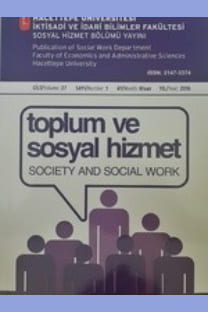LİSE ÖĞRENCİLERİNİN SOSYO-DEMOGRAFİK ÖZELLİKLERİ VE SOSYAL DESTEK DURUMLARI İLE BENLİK SAYGISI DÜZEYLERİ ARASINDA İLİŞKİNİN İNCELENMESİ
Benlik saygısı çocukluk döneminden itibaren oluşmaya başlayan ve bireyin
tüm yaşantısı etkileyen bir kavramdır. Benlik saygısının olumlu ya da olumsuz
bir biçimde şekillenmesinde aile, çevre gibi pek çok faktör etkili
olmaktadır. Bu çalışma kapsamında lisede okuyan 461 öğrenci ile görüşülmüş ve
oluşturulan görüşme formu uygulanmıştır. Araştırmada öğrencilerin benlik
saygıları, sosyo-demografik özellikler ve sosyal destek açısından ortaya
konmaktadır. Araştırmanın temel bulgularını özetlemek gerekirse, kızların,
anne ve babaları üniversite mezunu olanların, gelir durumu yüksek olanların
ve uzun süre kentte yaşayan öğrencilerin benlik saygısı düzeyleri diğerlerinden
daha yüksektir. Akademik başarısı düşük olan öğrencilerin benlik saygısı
düzeyleri, akademik başarısı yüksek olan öğrencilerden daha düşük bulunmuştur.
Sosyal destek açısından sonuçlar özetlenecek olursa, Tüm boyutlarıyla sosyal
desteğe sahip olan öğrencilerin benlik saygısı düzeyleri, sosyal desteğe sahip
olmayan öğrencilerden daha yüksek bulunmuştur.
Anahtar Kelimeler:
Benlik saygısı, sosyal destek
Assessment of the Relationship between Socio-Demographic Characteristics and Situation of Social Support and Level of Self Esteem of High School Students
Self esteem is a concept that is formed starting from
the childhood period and affecting an individual’s whole life. There are lots
of factors, such as family and environment, that affect positive or negative
formation of self esteem. In the context of this study, 461 students who study
at High School level were interviewed and a questionnaire was applied. In the
study, self esteem of students is revealed in terms of socio-demographical
characteristics and social support. To summarize the results, the females, the
students having mothers andfathers who are university graduates, the students
who have lived in a city for a long time and the students who have higher
income have higher levels of self esteem than others. The students who fail in
a class have lower levels of self esteem than others. The students who have
full social support have higher levels of self esteem.
Keywords:
Self esteem, social support,
___
- Barker, R.L. (1999) Social Work Dictionary. Washington DC, NASW Press.
- Büyükşahin Çevik, G. Atıcı, M. (2009) “Lise 3. Sınıf Öğrencilerinin Benlik Saygılarının Bazı Değişkenler Açısından İncelenmesi”. Uluslararası İnsan Bilimleri Dergisi, 6,2. 339-352.
- Coopersmith, S. (1967) The Antecedents of Self Esteem. San Francisco, CAA, Freeman.
- Coopersmith, S. (1981) Coopersmith Self- Esteem Inventory (school form). San Diego, CA, Consulting Psychology Press.
- Coopersmith, S. (1986) Self-esteem Inven- tories. Palo Alto, CA, Consulting Psycholo- gists Press.
- Dryfoos, J. G. (1998) Safe Passages: Ma- king it Through Adolescence in a Risky So- ciety. New York, Oxford University Press.
- DuBois, D., Lockerd, E., Reach, K. and Parra, G. (2003) “Effective Strategies for Esteem-Enhancement: What Do Young Adolescents Have to Say?” The Journal of Early Adolescence, 23.
- Duman, N. (2000) “Ankara Liselerinde Çe¬teye Katılma Potansiyeli Olan Öğrenci Grupları ve Okul Sosyal Hizmeti”, H.Ü. Sos¬yal Bilimler Enstitüsü Yayınlanmamış Dok¬tora Tezi, Ankara.
- Forney, S. W., Forney, C. J. and Crutsinger, C. (2005) “Gender, Delinquent Status, and Social Acceptance as Predictors of The Glo¬bal Self-Esteem of Teens”. Family and Con- sumer Sciences Research Journal 33; 208.
- Judge, T., Erez, A. and Bono, J. (1998) “The Power of Being Positive: The Relation Bet- ween Positive Self-Concept and Job Per- formance”. Human Performance, 11 (2/3).
- Harter, S. (1990) Causes, Correlates and The Functional Role of Global Self-Worth: a Life-Span Perspective. Competence Considered. New Haven, CT, Yale Univer- sity Press.
- Herz, L. and Gullone, E. (1999) “The Re- lationship Between Self-Esteem and Pa- renting Style: A Cross-Cultural Compari- son of Australian and Vietnamese Australi- an Adolescents”. Journal of Cross-Cultural Psychology, 30.
- Moran, M. and DuBois, D. (2002) “Relati¬on of Social Support and Self-Esteem to Problem Behavior: Investigation of Diffe- ring Models”. The Journal of Early Adoles- cence, 22.
- Mullis, A.K., Mullis, R.L. ve Normandin, D. (1992) “Cross-Sectional and Longitudinal Comparisons of Adolescent Self Esteem”, Adolescence, c.27, S.105, 51-60.
- Robertson, J. F., & Simons, R. L. (1989) “Family Factors, Self-Esteem and Adoles¬cent Depression”. Journal of Marriage and the Family, 51, 125-138.
- Rosenberg, M. (1965) Society and Adoles¬cent Self-Image. Princeton, NJ, Princeton University.
- Saygın, Y. ve Arslan, C. (2009) “Üniversite Öğrencilerinin Sosyal Destek, Benlik Say¬gısı ve Öznel İyi Oluş Düzeylerinin İncelen¬mesi” Selçuk Üniversitesi Ahmet Keleşoğlu Eğitim Fakültesi Dergisi, 28, 207 -222.
- Taysi, E. (2000) “Benlik Saygısı, Arkadaş¬lardan ve Aileden Sağlanan Sosyal Des¬tek”, Yayınlanmamış Yüksek Lisans Tezi, Ankara, Ankara Üniversitesi Sosyal Bilim¬ler Enstitüsü.
- Tufan, B. (1990) “Benlik Saygısı Kavramı ve Yaşam Boyunca Benlik Saygısının Gelişi¬mi”. Hacettepe Üniversitesi Sosyal Hizmet¬ler Yüksekokulu Dergisi, 8 (1 -2-3).
- Tufan, B. (1994) Göçmen İsçilerde İş Kaza¬ları. Ankara, SSK Yayını.
- Turan, N. ve Tufan, B. (1987) “Coopersmith Benlik Saygısı Envanteri Üzerinde Geçer¬lik, Güvenirlik Çalışması”, XIII. Ulusal Psi¬kiyatri ve Nörolojik Bilimler Kongresi, İstan¬bul, 14-18 Eylül.
- Uyanık Balat, G. ve Akman, B. (2004) “Fark¬lı Sosyo-Ekonomik Düzeydeki Lise Öğren¬cilerinin Benlik Saygısı Düzeylerinin İnce-lenmesi” Fırat Üniversitesi Sosyal Bilimler Dergisi, 14 (2), 175-184.
- ISSN: 2147-3374
- Yayın Aralığı: Yılda 4 Sayı
- Başlangıç: 2000
- Yayıncı: Hacettepe Üniversitesi İktisadi ve İdari Bilimler Fakültesi
Sayıdaki Diğer Makaleler
ÇOKKÜLTÜRCÜ SOSYAL HİZMET: ELEŞTİREL BİR BAKIŞ
Sunay İL, Veli DUYAN, Tarık TUNCAY
TOPLUMSAL DEĞİŞME SÜRECİNDE EVLENME VE BOŞANMA
HASTANE ORTAMINDA SOSYAL HİZMET UYGULAMALARI: ANKARA ÖRNEĞİ
Cengiz ÖZBESLER, Arzu İÇAĞASIOĞLU ÇOBAN
Sosyal Bir Problem Olarak İşsizlik ve Sonuçları
Uğur ÖMÜRGÖNÜLŞEN, M. Kemal ÖKTEM, A. Arda YÜCEYILMAZ
Selahattin GELBAL, Veli DUYAN, Çağrı SEVİN, Ercüment ERBAY
